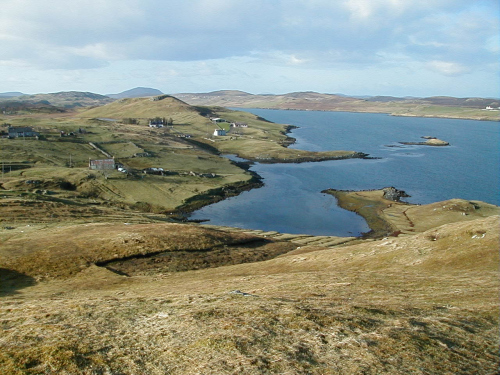Lady Habost
A woman known locally as ‘Lady Habost’ or ‘A Bhan Tighearna‘ existed and lived in a fine house where croft 13 Habost is now. She was not an officially titled lady, but the grand-daughter of John Macleod (lain Mhic Thorcuill), tacksman of Hacklete in Bernera, Lewis.
John Macleod had a son by the name of Donald who was known as ‘Donald of Lewis’. He had at least two sons and three daughters, John, Donald, Christianne, Mary and Barbara. It was Barbara who was known as Lady Habost. She married Angus ‘Ruadh’ Smith, Sheildinish, who was born in 1736, and he entered upon the tenancy of the joint tack of Habost and Cleitir in 1775.
Barbara’s brother, John Macleod of Colbecks, was a wealthy planter in Jamaica, and he left an annuity of £20 to Barbara, and each of his other two sisters. That was a considerable sum then and doubtless the local people felt that she was very well off, hence their reference to her as ‘Lady’, because she was affluent and possibly generous.
Local tradition associates Barbara ‘A Bhan Tighearna’ with a seafaring Captain, which might have been her brother who was the owner of ships that traded with overseas ports, even as distant as the Pacific. From time to time the Captain took his ship into Loch Erisort where he anchored and brought unusual things to Lady Habost.
Tradition also speaks of the fine house Lady Habost had, and that the roof was covered with red tiles which the Sea Captain brought to Habost from his overseas trading. The story about the red tiles seems to gain credibility, if not confirmation, from the fact that fragments of red tiles were unearthed at the site of the house in Habost, Lochs, and some of them are preserved by John M. Macleod of 15 Balallan, a distant relative of Lady Habost.
Local tradition also associates a Sea Captain with a subsequent tacksman at Habost, ‘Allan Mac a’ Mhinisteir’, thought to be Allan Morrison, possibly Allan’s brother who traded with distant overseas places. The inference is that there were at least two Sea Captains or more that frequented Loch Erisort.
The alleged activities of one of these Sea Captains associates him with white slavery, as it was said that one of these ships sailed away with a ship load of Island girls on the pretence of obtaining employment for them on the mainland, but none of them were ever heard about again, except that two Lewis soldiers serving in India happened to meet a girl there who identified herself as a girl from Laxay who was detained in the house of the Indian Potentate.
The tradition of white slavery could be true. W.C. Mackenzie in his book History of the Outer Hebrides, pp 477-78, describes how, in the 18th century, the Captains of emigrant ships searched systematically for passengers in every remote island, and kidnapping became a common occurrence. A vessel named ‘Philadelphia’ called at Stornoway, and the Master proceeded to kidnap boys off the beach and lock them up on board his ship without the consent of their parents or their employers.
In her widowhood, Lady Habost moved to Balallan where her brother, Donald Macleod, had been tacksman. In a list of tenants at Balallan in 1808, she is entered as ‘Lady Habost’, but the name is deleted and substituted by another name, which might indicate that she may have died about that time. Posted by cepaircadmin | 0 comments
